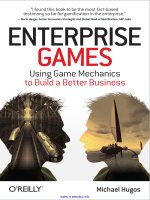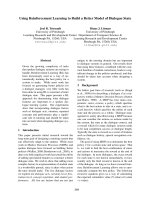Hire With Your Head_ Using Performance-Based Hiring to Build Great Teams
Bạn đang xem bản rút gọn của tài liệu. Xem và tải ngay bản đầy đủ của tài liệu tại đây (11.87 MB, 322 trang )
HIRE
HEAD
with
your
third
edition
Using Performance-based Hiringsm
to Build Great Teams
Lou Adler
John Wiley & Sons, Inc.
HIREyour
with
HEAD
HIRE
HEAD
with
your
third
edition
Using Performance-based Hiringsm
to Build Great Teams
Lou Adler
John Wiley & Sons, Inc.
Copyright © 2007 by Lou Adler. All rights reserved.
Published by John Wiley & Sons, Inc., Hoboken, New Jersey.
Published simultaneously in Canada.
Wiley Bicentennial Logo: Richard J. Pacifico
No part of this publication may be reproduced, stored in a retrieval system, or transmitted
in any form or by any means, electronic, mechanical, photocopying, recording, scanning, or
otherwise, except as permitted under Section 107 or 108 of the 1976 United States Copyright
Act, without either the prior written permission of the Publisher, or authorization through
payment of the appropriate per-copy fee to the Copyright Clearance Center, Inc., 222
Rosewood Drive, Danvers, MA 01923, (978) 750-8400, fax (978) 646-8600, or on the web at
www.copyright.com. Requests to the Publisher for permission should be addressed to the
Permissions Department, John Wiley & Sons, Inc., 111 River Street, Hoboken, NJ 07030,
(201) 748-6011, fax (201) 748-6008, or online at />Limit of Liability/Disclaimer of Warranty: While the publisher and author have used their
best efforts in preparing this book, they make no representations or warranties with respect
to the accuracy or completeness of the contents of this book and specifically disclaim any
implied warranties of merchantability or fitness for a particular purpose. No warranty may be
created or extended by sales representatives or written sales materials. The advice and
strategies contained herein may not be suitable for your situation. You should consult with a
professional where appropriate. Neither the publisher nor author shall be liable for any loss
of profit or any other commercial damages, including but not limited to special, incidental,
consequential, or other damages.
For general information on our other products and services or for technical support, please
contact our Customer Care Department within the United States at (800) 762-2974, outside
the United States at (317) 572-3993 or fax (317) 572-4002.
Wiley also publishes its books in a variety of electronic formats. Some content that appears
in print may not be available in electronic books. For more information about Wiley
products, visit our web site at www.wiley.com.
Library of Congress Cataloging-in-Publication Data:
Adler, Lou.
Hire with your head : using performance-based hiring to build great
teams / Lou Adler.—3rd ed.
p. cm.
ISBN 978-0-470-12835-0 (cloth)
1. Employee selection. 2. Employees—Recruiting. 3. Employment
interviewing. I. Title.
HF5549.5.S38A35 2007
658.3'11—dc22
2007012416
Printed in the United States of America.
10
9
8
7
6
5
4
3
2
1
Foreword
Since the early 1990s, I’ve been advising business leaders in organizations ranging from JC Penney to JP Morgan Chase on how to leverage talent to meet their business objectives. One piece of advice
that is a slam dunk is this: Buy a copy of Lou Adler’s Hire with Your
Head for yourself, read it, and then buy copies for every hiring manager, every recruiter, and every human resources professional in
your organization. Why? Because this book offers a systematic approach to Performance-based Hiring and that is the most important
thing you’ll ever do to build your team.
As much as things change in the business world from week to
week and year to year, there is one fact that isn’t going to change:
Talent is the number one asset in every organization. That has always been true, but the value of talent is even more important in
the changing economy than ever before.
Organizations in every industry are trying to increase productivity and quality and they cannot rely on technology alone to achieve
those objectives. As employers cut waste, introduce new technologies, and streamline operations, they put even more pressure on individuals to “add value” on a daily basis. Every operation nowadays
must be lean, flexible, and high performance. Every supervisor is
under pressure to get more and better work out of fewer people.
That means those few people had better be really, really good.
High performance under pressure is what the real new economy is
really all about. Technology implementation will continue, organizations will become even leaner, the pace of change will get even
faster, competition will be even more intense, businesses will become even more customer focused, expected response times will
get shorter, and productivity expectations will grow. The whole
game is moving to a higher level.
v
vi
➤
FOREWORD
That’s why there is a growing premium on people—at all ends of
the skill spectrum—who can work smarter, faster, and better. You
want your people to be innovative (within guidelines), passionate
(within reason), and armed with sufficient discretion to make mistakes (as long as they are not too big). In lean, restructured companies, the best employees are handling more responsibility, using
greater technical skill, and applying more precious human judgment than ever before. Every individual, like every business, has
his or her own value proposition to offer employers in the free market for talent, which really means simply: “Here’s what I can do.”
That value proposition is strictly business. One really good person
is worth a whole pile of mediocre people. Really good people “can
do” real things (very well and very fast) that add real value to your
bottom-line. They know it just as well as managers know it.
We’re talking about that senior executive talent who can turn
around a division in 18 months. The programmer who can write two
lines of code for every one that an ordinary programmer writes. The
call-center operator who can dazzle every customer, gather market
research on the front lines, and routinely suggest improvements in
the whole system. The salesperson in the field who can sell anything to anybody and who also monitors warehouse inventory and
the production schedule from his palm computer. The warehouse
manager who knows everybody by name and also knows the new
database inside and out. The nonphysician health professional who
delivers care previously reserved only for doctors. And the soldier
operating a laptop computer mounted on a tank in the midst of battle who turns around, as soon as the battle is won, and plays the
role of peacekeeper.
Regardless of fluctuations in the labor market, demand for
those great people is going to outpace supply for the foreseeable
future. And hereafter, in the real new economy, there’s going to be a
perpetual struggle in the marketplace to leverage the value of
labor. How do you go about sourcing, attracting, and selecting the
best people?
Business leaders, managers, and hiring professionals who fail to
take a long-term strategic approach to hiring in today’s rapidly
changing business world will face a perpetual staffing crisis. You
may be understaffed one day and overstaffed the next; the problem
Foreword
➤
vii
is, you won’t be intelligently staffed with the right people in the
right places at the right times.
If you want to be intelligently staffed, you have to hire with your
head. Seize control of your talent supply chain, just as you have
with other critical resources. That means you need the kind of systematic approach Lou Adler offers in this book.
Throughout most of the industrial era and until recently, the
dominant staffing model for most employers was based on longterm, full-time, on-site employment relationships. But in today’s
quickly changing marketplace, where employers can never predict
what is just around the corner, the old-fashioned, stable, til-retirement-do-us-part employer-employee relationship just doesn’t fit.
The key to continued success for companies today is the ability to
adapt rapidly to new circumstances—staffing may have to expand
rapidly in one skill area, or contract rapidly in another—or do both at
the same time. Staffing strategy must be geared to face this reality.
People in today’s workforce want to know what you want from
them today, tomorrow, next week, and next month and exactly what
you have to offer them in return. Create a compelling recruiting
message by answering the fundamental question people want answered: “What’s the deal?” To be effective in today’s labor market,
you need to be communicating that message through an aggressive
and year-round effort to a wide range of well-chosen candidate
sources. Why? If you attract an applicant pool that is sufficiently
large, you can be very, very selective when it comes to the ultimate
hiring. You must be prepared to implement a rigorous selection
process that is all about collecting proof that potential hires have
the skills they need to get up to speed and start contributing right
away.
What you’ll find in this book is a step-by-step process with detailed instructions for taking a logical, systematic approach to getting the right new-hire in the right place at the right time every time.
We all owe Lou Adler our thanks for the third edition of this gem.
BRUCE TULGAN
Author of Winning the Talent Wars and
founder of RainmakerThinking, Inc.®
Contents
Chapter 1
Chapter 2
Performance-based Hiring: A Systematic
Process for Hiring Top Talent
1
Performance Profiles: Define Success,
Not Skills
29
Talent-Centric Sourcing: Finding the Best
Active and Passive Candidates
65
Chapter 4
The Two-Question Performance-Based Interview
99
Chapter 5
The Evidence-Based Assessment
135
Chapter 6
Everything Else after the First Interview:
Completing the Assessment
167
Chapter 7
Recruiting, Negotiating, and Closing Offers
197
Chapter 8
Implementing Performance-based Hiring
233
A.
The Legality of Performance-based Hiring
Robert J. Bekken, Esq.
265
B.
A Discussion of the Validity of the
Structured Interviews Used in the
Performance-based Hiring Process
Charles A. Handler, PhD
Chapter 3
Appendixes
C.
Index
Forms and Templates
277
283
291
xvii
Preface
I became a line manager for a Fortune 100 company in my mid-20s.
Within days, and with no interview training, I was sent on a corporate recruiting trip to a few of the top MBA schools in the country.
The vice president of human resources (HR) called me before leaving and gave me three minutes of advice on how to interview. What
he said still sticks in my mind today. It was wrong, but it was the
only training I had, and it seemed reasonable at the time.
He said to consider only candidates who possessed the 4A attributes of success—assertive, affable, attractive, and articulate.
With this benchmark and a decent resume, I could determine
competency in 15 minutes. Or I thought I could. As I look back, this
process was about 60 percent to 65 percent effective in predicting
subsequent success. This was true for the 30 to 40 people I hired
to work for me personally and for the 50 to 100 I recommended to
work for others. I hired some duds, but I hired enough great people that I got promoted very quickly. Within six years, I was a business unit manager for a division of a Fortune 500 company. One
thing I did learn was that hiring great talent is the key to a manager’s career progression. I also found out that being a headhunter
and helping other managers hire great people was a far more lucrative career.
THE BEST ARE DIFFERENT THAN THE REST
Despite the weak predictive value of the 4A interview approach, I
still used it with great success as a headhunter in my early days. Because I started out as a contingency recruiter (i.e., I only got paid
when a candidate was hired), it wasn’t too hard to find people who
ix
x
➤
PREFACE
met the superficial 4A criteria and who could last the short 90-day
guarantee. At the time, most of our competitors offered only 60
days, so this was a competitive advantage. Everything changed
when I became a retained recruiter and offered a one-year guarantee. Under this provision, the person had to actually be competent,
not just appear so. A decent resume and the 4A criteria were no
longer sufficient for judging talent. Finding the correct criteria for assessing talent was how Performance-based Hiring came into being.
It took about five years to figure out the basics. Now, 20 years later,
I’m still perfecting it. This book is pretty close.
As I studied the recruiting and hiring process, I found out some
other interesting things. First, the most suitable or the best person
rarely got the job; instead, the person with the best interviewing
and presentations skills did. This is the old 4A conundrum: The
most attractive, affable, articulate, and assertive person who was
reasonably qualified generally got the offer. Worse, when people
were hired this way, money typically became the primary decision
criteria. Although these people were competent, they typically
were unmotivated to do the actual work required since this wasn’t
the basis of the selection criteria.
There were some other interesting things I discovered
along the way about the differences between top people and
everyone else:
➤ There is no correlation between interviewing and presentation skills and on-the-job performance. Judging people on
how well they interview is a terrible way to assess ability.
➤ Top performers don’t use the same criteria or methods
when looking for other jobs. Now that it’s so easy to find
new jobs, more and more passive candidates now look online. However, these people are looking for bigger jobs or
better jobs and more career opportunities. When they do
look, they spend less time at it. Unfortunately, most advertising and screening methods are targeting the wrong pool
of candidates—those who have ample time to look for similar jobs.
➤ The best people use more decision variables when deciding whether to accept an offer. They also drop out quickly
Preface
➤
xi
along the way if things seem incongruous or unprofessional.
When getting an offer, they also take longer to decide, and
they consult with more advisors. Unfortunately, most hiring
processes are geared around the needs of the average candidate, not the best. For the average candidate, a new job is
a tactical move based on short-term criteria. For the best,
it’s a strategic move. This fundamental difference is rarely
considered in a company’s hiring processes.
➤ The best candidates don’t typically have the exact mix
of skills, experience, and education described in the job
description. They make up for this with traits that can’t easily be filtered—potential, self-motivation, leadership,
tenacity, and vision. So if a company advertises and
filters totally on skills, the best are wrongly excluded from
consideration.
➤ Boring job descriptions exacerbate the problem. Unless a
company is an employer-of-choice, top people aren’t going
to apply for run-of-the-mill jobs that seem the same as everyone else’s.
➤ Many top people get nervous when being interviewed. This
reveals itself as poor eye contact, short or shallow answers,
lack of poise, and less self-confidence. This excludes many
good candidates for superficial reasons.
Companies that don’t design these differences into their hiring
systems wind up seeing fewer top people and, by default, hire the
wrong type of candidate. The best people really are different from
the rest, not only in how they perform on the job, but also in how
they look for new jobs and the criteria they use to accept one offer
over another. Few companies take these fundamental differences
into account.
The candidate-facing side is only half the problem though. Here
are some other things I discovered about hiring managers and those
on the hiring team that need fixing:
➤ Most hiring managers and other members of the selection
team aren’t very good at interviewing, yet they all think they
are. Each one also uses his or her own pet criteria to judge
xii
➤
➤
➤
➤
➤
➤
PREFACE
competency. Much of it is downright illogical, a lot of it is
prejudicial, and most of it is a waste of time.
Most members of the interviewing team don’t understand
the real job, but they all have an important say, even if
they’re unprepared or conduct superficial interviews. In
these cases, a no vote is the safer decision, and no votes
have more weight than yes votes. This is why some of the
best candidates are bypassed. It’s also why many of the best
people pull themselves out of the process, not wanting to
work at companies that conduct superficial interviews.
The assessment process is in worse shape than the interviewing process. Too many interviewers make quick decisions about the candidates they’re interviewing, then they
collect facts to support this initial biased assessment. Matters are made worse when all of the interviewers get together and use an up or down voting system with little
debate or analysis to decide whether a person is hired or
not. The lack of a formal evidence-based assessment process, comparable to how other major business decisions are
made, is inexcusable.
When anyone on the interviewing team finds a candidate
they think is hot, they go into immediate sales mode. They
also stop listening and stop evaluating competency in a
transparent attempt to excite the hot prospect on the merits
of the job. This not only cheapens the job and drives many
top people away, but also requires premium pricing. More
times than not, the hot candidate is just an overpaid flash in
the pan.
Very few people know how to deal with the current legal environment. Stupid things are said and done, causing companies to pay outrageous defense and liability fees that
could have been simply avoided. Other companies overreact to the fear of these costs and establish policies and procedures that preclude them from hiring the best.
Few managers know how to negotiate salaries and make
offers. Hiring the best requires a consultative process
addressing a number of short- and long-term career management and personal issues. The best candidates must
Preface
➤
xiii
balance these against competing alternatives. Few companies put their salespeople in the field without some type
of extensive formal training. In most companies, comparable
hiring and recruiting training seems to be unnecessary or
too costly.
If a company wants to consistently hire superior people, it
needs to implement a system that everyone uses that is designed
to find and hire superior people. By default, most companies use a
system that is designed to fill jobs. It’s hard enough to hire one
great person. It’s even harder to hire 5 or 10 great people. But somehow when we get to thinking about hiring tens or hundreds, we lose
sight of what it takes to hire just one great person. In this book, we
show you how to hire one great person hundreds of times. For this
to work, all of the problems noted earlier need to be overcome.
While I’ve observed all of these problems over the years, I’ve
also observed a number of managers, HR people, and recruiters
who seem to get it right most of time. They’ve mastered the rules of
the game. Most have learned through trial and error. I’ve watched
them in action, then tried their ideas out. I then further refined
these ideas and tried them out again. I’ve also tracked candidates
for years to determine the best predictors of subsequent success.
Eventually, a few fundamental principles became clear, which
formed the foundation for a systematic process for hiring top people. This became the Performance-based Hiring methodology described in this book.
Then came the Internet, job boards, new referral programs, candidate tracking systems, new types of assessment testing, and passive candidate name-generating systems. With all of these great
tools now available, everything was supposed to change. Hiring the
best would be as easy as posting an ad or making a phone call.
These tools overpromised and underdelivered.
In many ways, these tools made it more difficult to hire top people, not easier. For one thing, the hidden job market is no longer
hidden. The new tools make it easier for a passive candidate to find
another job within days. This adds more competition into the mix.
For recruiters, passive candidates are now easier to find, but harder
to attract with everyone emailing and calling the same people.
These tools have broken down the barriers to leaving a company,
xiv
➤
PREFACE
increasing workforce mobility while decreasing company loyalty.
There is no longer a stigma to looking for other jobs and accepting
counter-offers.
In this third edition of Hire with Your Head, I describe how to use
these tools to your advantage, but this represents a small change in
tactics, not a change in philosophy. The primary goal of this book is
to show every manager and every recruiter how to hire one great
person. The secondary goal is to show how to do it over again, and
again, and again.
Here are seven ways to get it done:
1. Stop using traditional boring job descriptions for advertising. Top people don’t look for jobs based on their skills and experience.
They look for jobs based on the challenges and opportunities involved.
2. Make the job description the real job. Most job descriptions list
skills, required experiences, academics, competencies, and
personality traits, with a little about duties and responsibilities. This is more a people description than a job description. Instead, define what people need to do with their skills
and experiences. These are called performance profiles.
You’ll use them to screen, assess, and recruit every one of
your candidates.
3. When the supply of top talent is less than the demand, you need to design your advertising and sourcing programs and systems based on how
the best look for new jobs. Somehow, most companies have not
considered this fundamental principle of marketing and
economics when creating their hiring and recruiting
processes.
4. During the interview, forget the clever questions. Instead, dig
deeply into a person’s major accomplishments to observe
trends of growth and patterns of behaviors. Then compare
these to the performance objectives stated in the performance profile. This is the core of the performance-based interviewing process described in this book.
5. Hire people who are both competent and motivated to do the work. It’s
easy to measure competency, but don’t stop there even if
the person is affable, outgoing, and interested in your job.
Preface
➤
xv
To assess true motivation, you’ll need to look for multiple
examples of where the person has excelled and the underlying environment and circumstances.
6. During the interview, put your emotions in the parking lot. Implement an evidence-based assessment process, which
means use the interview to collect information, not to make
a decision. The decision is made later in a formal meeting
where all interviewers share this unbiased information to
reach consensus. Watch your accuracy soar with this simple
system.
7. As the competition for talent intensifies, strong recruiting skills are essential for hiring top people on a consistent basis. This requires strong
consultative selling skills in combination with great jobs, an
interviewing process based on deep job-matching, and the
hiring manager’s total involvement. Too many companies still
rely on a transactional approach to recruiting based on
money, charming or pushing a candidate into acceptance.
Collectively, these ideas and principles are embedded in the
Performance-based Hiring process described in this book. However, this book is not about principles; it’s about tactics. It describes
how to hire one great person again and again. Don’t lose sight of
this concept as you build systems to hire dozens or hundreds of
great people. Each great person is unique. Treat him or her this way.
Implemented properly, Performance-based Hiring can become
your systematic process for hiring top talent.
LOU ADLER
Laguna Beach, California
January 2007
HIREyour
with
HEAD
1
Chapter
Performance-based
Hiring: A Systematic
Process for Hiring
Top Talent
Hire smart, or manage tough.
—Red Scott
■ A RUDE AWAKENING—WHAT IT REALLY TAKES
TO GET AHEAD
I still remember the following situation like it was yesterday. I got
the call sometime in the morning on a mid-October day in 1972 at
my first management job, financial planning manager at Rockwell
International’s Automotive Group in Troy, Michigan. At the time, I
was working on my first presentation, due the next day, to the
Group’s president and vice president of finance. It was going to be a
very long day and night. I didn’t mind, since my new wife hadn’t
made the move to Michigan yet. My boss, Chuck Jacob, and the reason for my being in Michigan, was on the phone with a desperate
plea. Chuck was a 29-year-old Harvard MBA whiz kid, just out of
Ford Motor Company, trying to prove to everyone that he deserved
his position as controller for this multibillion-dollar automotive
1
2
➤
HIRE WITH YOUR HEAD
supplier. He was also my idol. I listened. He was over at the University of Michigan interviewing MBA students for planning analyst
positions to fill out our department. We needed these people urgently. The good news—too many had signed up for the interview,
and Chuck needed me there to interview the overflow. We were
going head-to-head with Ford, Procter & Gamble, IBM, and every
other top Fortune 500 company, who wanted the best candidates
from this prestigious MBA program. He told me there were stars in
this group that we needed on our team. The bad news—I didn’t
have a minute to spare. I protested, vehemently, pleading 14-hour
days, a long night, and a critical presentation the next day. There
was a momentary delay. Chuck’s response still blasts in my ears
today: “There is nothing more important to your success than hiring great people! Nothing. We’ll somehow get the work done. Get your
over here
now.” He then hung up.
I was there within the hour. Together we interviewed about 20
people, took eight of them to dinner that night in Ann Arbor, and
hired three of the top MBA students within two weeks. I’ve lost track
of Russ, Joe, and Vivek, but I want to thank them and Chuck (who
passed away at a too-early age) for an invaluable lesson: There is
nothing more important—to your personal and company success—than hiring
great people. Nothing. Chuck and I got back to the office at 10:00 P.M.
that night and worked together until 3:00 A.M. to finish the report.
The handwritten version was presented the next day to Bob
Worsnop and Bill Panny. We apologized for the format and lack of
preparation, but told them we were doing something more important. They agreed.
■ BENCHMARKING THE BEST
I learned 50 percent of what I needed to know about hiring that day.
Since then, I’ve been trying to understand the rest. I’m not quite
there yet, but close. For the past 30-plus years, I’ve been fortunate
to be able to work with other people, like Chuck, who always seem
to hire great people, year in and year out. Few have had any formal
training. They learned through trial and error. Equally important,
I’ve lived and worked with managers who’ve made every possible
hiring mistake in the book. This is their book, too. It’s the collective
stories of the good and the bad, sharing what to do and what not to
do. There are some great techniques in this book, but none are
Performance-based Hiring
➤
3
more important than your belief that hiring great people is the single most important thing you can do to ensure your own success.
Many years later, I heard Red Scott’s adage, “Hire smart, or manage
tough.” As far as I was concerned, this summarized everything. I’ve
never met anybody who could manage tough enough. No matter
how hard you try, you can never atone for a weak hiring decision. A
weak candidate rarely becomes a great employee, no matter how
much you wish or how hard you work. Instead, hire smart. Use the
same time and energy to do it right the first time. Brian Tracy of
Nightingale-Conant fame said on one of his audio programs that effective hiring represents 95 percent of a manager’s success. This
seems a little high, but from what I’ve seen, 70 percent to 80 percent
seems about right to me. This is still enough to keep hiring top talent in the number one position.
Every manager says hiring great people is their most important
task; however, few walk the talk. Although important, it never seems
urgent enough until it’s too late. When it really comes down to the
actual hiring process, our words don’t match our actions. Here’s how
you can quickly test yourself to see how well you score as a hiring
manager. Rank the performance of every member of your own team.
Are most of them top-notch and exceeding expectations on all aspects of their work without being pushed? If they are, consider
yourself a strong manager. Unless you’re hiring people like this 80
percent to 90 percent of the time, you need to throw out everything
you’ve learned about hiring, and start with a fresh new slate. If
you’re already in the elite 80 percent to 90 percent, don’t relax.
We’re undergoing some major workforce shifts that will make it even
more difficult to continue to hire great people every time.
Ongoing demographic changes, global expansion, the Internet,
and the great dot-com boom and bust changed the hiring rules forever. This resulted in a cultural shift of major proportions. Changing
jobs every few years no longer carries the stigma it did pre-2000.
Company loyalty is no longer a hallmark of character. It is no wonder,
considering that reductions in pension plans, the shifting of the cost
of health care to the employee, and the outsourcing of whole departments have forced each employee to look out for him- or herself. Companies no longer set the hiring rules, the best people do.
While this has always been true, evidence abounds that this shift is
accelerating. Just consider the increase in turnover. Retention is
now the new buzzword and focus, as companies attempt to stem









